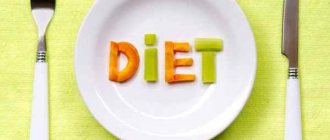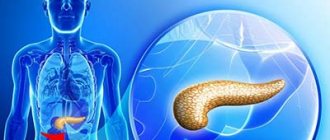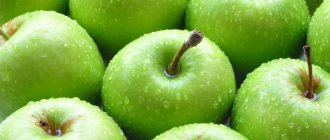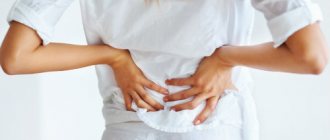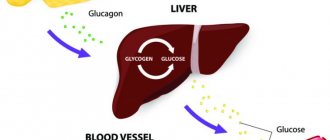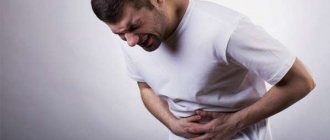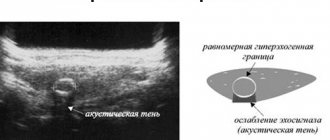When a malfunction occurs in the body, not only the general well-being suffers, but also the condition of all organs, because it is their connection that ensures the full functioning of the system. The pancreas, as many believe, is not a useless organ and the production of enzymes responsible for digesting food, as well as insulin, the lack of which can lead to diabetes, depends on its health.
Rating - 4 out of 5 possible based on 8 votes
But no one is immune from pancreatic diseases - anyone can experience a malfunction that can be corrected with proper nutrition. HOCHU.ua will tell you what diet you should follow for pancreatic diseases.
Content
- What not to eat
- What can you eat?
- What should you limit in food?
- Diet table No. 5
- Sample menus and recipes
- Answers to frequently asked questions about the pancreas
- What can you eat if you have inflammation of the pancreas?
- Heaviness in the pancreas
- Pancreas and alcohol
- If your pancreas hurts, what can you eat?
- Nutrition after pancreatic surgery
- Diet for stones in the pancreas
- Avocado and pancreas
- Diet schedule for pancreatic diseases
- Decoctions and tinctures of herbs for the pancreas
For children
What can you eat when your child’s pancreas hurts? The children's diet is almost the same as that of adult patients. In young patients, the time for aggravation of the pancreas often passes faster. In case of pathology of the pancreas, therapeutic nutrition still remains for a long period and is suitable for the age category of the patient.
At the appointment after the prescribed diet for the pancreas, the doctor will tell you what can and cannot be given to the child when the organ hurts.
pediatrician
The dietary table for a child with pancreatic disease largely includes soups, as well as carefully boiled porridges. Cooking takes place with diluted milk or using water. Pureeed vegetables and baked apples are better suited for a child’s body. Fats and sweets should be kept to a minimum. Dishes made from meat products should be light.
Foods to Avoid
If you have a disease of the pancreas, you are prohibited from eating any food that increases the production of enzymes designed to break down food. Abuse of these products leads to the body producing large quantities of enzymes necessary for digesting and breaking down food. These enzymes are secreted in large quantities. As a result, inflammation of the organ occurs and serious complications and diseases occur. Such products include:
Fried and fatty foods (not allowed)
Product Proteins, (g) Fats, (g) Carbohydrates, (g) Calorie content, kilocalories Note Fried lard 1.80 g 84.00 g 0.00 g 754.20 kcal (3157 kJ) Eliminate completely! Fried eggs in lard 15.20 g 125.30 g 0.80 g 295.00 kcal (1234 kJ) Eliminate completely! Roast pork 15.47 g 33.93 g 0.85 g 364.98 kcal (1527 kJ) Eliminate completely! Roast beef 27.58 g 18.24 g 0.55 g 279.58 kcal (1170 kJ) Eliminate completely! Fried potatoes 2.75 g 9.55 g 23.19 g 184.81 kcal (773 kJ) Eliminate completely! Fried fish 17.37 g 10.55 g 6.18 g 186.98 kcal (782 kJ) Eliminate completely! Fried pies 4.70 g 8.80 g 47.80 g 290.50 kcal (1216 kJ) Eliminate completely! Fried chicken 31.65 g 13.20 g 0.63 g 231.03 kcal (967 kJ) Eliminate completely! Roast duck 16.00 g 38.00 g 0.00 g 405.00 kcal (1695 kJ) Eliminate completely! Flour and sweet products (not allowed)
Product Proteins, (g) Fats, (g) Carbohydrates, (g) Calorie content, kilocalories Note Pancakes 8.43 g 8.51 g 28.03 206.12 kcal (862 kJ) Eliminate completely! Cheesecakes 11.90 g 6.40 g 38.90 g 264.00 kcal (1105 kJ) Eliminate completely! Sponge-cream cake 2.30 g 8.40 g 22.54 g 172.00 kcal (719 kJ) Eliminate completely! Rye bread 6.43 g 2.05 g 45.47 g 224.80 kcal (941 kJ) Eliminate completely! Chocolate cake 4.97 g 23.53 g 45.22 g 402.93 kcal (1686 kJ) Eliminate completely! Sour Cream Cake 4.73 g 15.64 g 40.66 g 323.86 kcal (1355 kJ) Eliminate completely! Ice cream 3.94 g 10.20 g 22.67 g 198.45 kcal (830 kJ) Eliminate completely! Dark chocolate 5.36 g 31.91 g 51.26 g 513.29 kcal (2148 kJ) Eliminate completely! Smoked meats, canned food, sausages (not allowed)
Product Proteins, (g) Fats, (g) Carbohydrates, (g) Calorie content, kilocalories Note Smoked ham 18.63 g 39.23 g 0.34 g 350.90 kcal(1468 kJ) Eliminate completely! Smoked sausage 16.69 g 38.82 g 2.52 g 429.90 kcal (1799 kJ) Eliminate completely! Homemade sausage 15.21 g 30.93 g 2.71 g 363.32 kcal (1520 kJ) Eliminate completely! Sausage "Moskovskaya" 21.95 g 38.78 g 11.86 g 441.50 kcal (1848 kJ) Eliminate completely! Canned fish 19.00 g 17.00 g 0.00 g 229.00 kcal (958 kJ) Eliminate completely! Canned squid 12.00 g 1.20 g 0.00 g 58.00 kcal (242 kJ) Eliminate completely! Canned Far Eastern seaweed salad 1.00 g 10.00 g 7.00 g 122.00 kcal (510 kJ) Eliminate completely! Canned cod liver 4.20 g 65.70 g 1.20 g 613.00 kcal (2566 kJ) Eliminate completely! Dairy products (not allowed)
Product Proteins, (g) Fats, (g) Carbohydrates, (g) Calorie content, kilocalories Note Glazed cheese 8.55 g 24.92 g 32.75 g 385.41 kcal (1613 kJ) Eliminate completely! Homemade fat cottage cheese 15.94 g 19.80 g 2.52 g 215.40 kcal (901 kJ) Eliminate completely! Homemade sour cream 2.97 g 21.56 g 3.93 g 226.71 kcal (949 kJ) Eliminate completely! Smoked cheese 31.05 g 21.88 g 2.55 g 337.20 kcal (1411 kJ) Eliminate completely! Salted cheese 17.90 g 20.10 g 0.00 g 260.00 kcal (1088 kJ) Eliminate completely! Homemade cheese 14.00 g 9.00 g 2.20 g 158.00 kcal (661 kJ) Eliminate completely! Mayonnaise 2.70 g 52.14 g 6.62 g 500.96 kcal (2097 kJ) Eliminate completely! Fruits, vegetables (not allowed)
Product Proteins, (g) Fats, (g) Carbohydrates, (g) Calorie content, kilocalories Note Turnip 1.62 g 0.06 g 4.87 g 29.31 kcal (122 kJ) Eliminate completely! cucumbers 1.13 g 0.13 g 4.17 g 19.62 kcal (82 kJ) Eliminate completely! Tomatoes 1.06 g 0.35 g 4.96 g 22.38 kcal (93 kJ) Eliminate completely! Mushrooms 3.62 g 1.93 g 3.52 g 44.14 kcal (184 kJ) Eliminate completely! White cabbage 2.97 g 0.05 g 5.76 g 28.46 kcal (119 kJ) Eliminate completely! Eggplant 0.90 g 0.21 g 5.75 g 25.92 kcal (108 kJ) Eliminate completely! Pomegranate 1.07 g 0.33 g 13.47 g 55.98 kcal (234 kJ) Eliminate completely! Oranges 0.81 g 0.16 g 8.73 g 39.69 kcal (166 kJ) Eliminate completely! Sour apple 0.40 g 0.40 g 9.80 g 42.00 kcal (175 kJ) Eliminate completely! Grape 1.10 g 0.68 g 17.10 72.57 kcal (303 kJ) Eliminate completely! Drinks (not allowed)
Product Proteins, (g) Fats, (g) Carbohydrates, (g) Calorie content, kilocalories Note Orange juice 0.63 g 0.11 g 11.44 g 48.04 kcal (201 kJ) Eliminate completely! Apple juice 0.28 g 0.04 g 10.70 g 44.63 kcal (186 kJ) Eliminate completely! Apricot juice 0.26 g 0.03 g 11.84 g 45.90 kcal (192 kJ) Eliminate completely! Grapefruit juice 0.60 g 0.10 g 7.64 g 34.11 kcal (142 kJ) Eliminate completely! Lemonade 0.00 g 0.00 g 6.00 g 32.00 kcal (133 kJ) Eliminate completely! Coffee 6.22 g 3.83 g 8.33 g 78.20 kcal (327 kJ) Eliminate completely! Strong tea 9.91 g 6.32 g 47.91 g 250.85 kcal (1050 kJ) Eliminate completely! Cold water 10.65 g 8.43 g 22.04 186.91 kcal (782 kJ) Eliminate completely!
Acceptable food
The products described below should be consumed rarely. And if possible, completely exclude it from your diet. Because they are hard on the stomach and overly strain the pancreas. When consuming such products, malfunctions of the pancreas occur. Such products include:
By-products, sausage (limit)
Product Proteins, (g) Fats, (g) Carbohydrates, (g) Calorie content, kilocalories Note Chicken liver 19.75 g 6.66 g 1.04 g 142.60 kcal (596 kJ) It is recommended to boil or stew chicken liver; you can prepare pate or casserole. Pork liver 18.99 g 4.22 g 3.38 g 116.38 kcal (487 kJ) It is recommended to use no more than once every 3-4 weeks. The most important thing is long soaking (2-3 hours). Cod liver 4.88 g 61.39 g 1.45 g 590.56 kcal (2472 kJ) Eat 3-4 teaspoons of cod liver no more than once a month. Doctor's sausage 12.76 g 22.65 g 1.60 g 251.94 kcal (1054 kJ) The composition must include meat (beef or pork) of the highest grade or 1st grade. Before eating, boil the sausage for 5-10 minutes, removing the protective casing. Do not consume every day in quantities up to 50 grams. Sweets (limit)
Product Proteins, (g) Fats, (g) Carbohydrates, (g) Calorie content, kilocalories Note Marmalade 0.90 g 0.94 g 74.58 g 304.77 kcal (1275 kJ) A few pieces a day Waffles without filling 3.20 g 2.80 g 81.00 g 342.00 kcal (1431 kJ) Reduce their consumption to approximately 100 grams per day for an adult of average build Apricot jam 0.00 g 0.00 g 62.00 g 236.00 kcal (987 kJ) You can eat a maximum of three teaspoons of jam per day. Fats, eggs (limit)
Product Proteins, (g) Fats, (g) Carbohydrates, (g) Calorie content, kilocalories Note Butter 60% 0.50 g 7.00 g 1.20 g 547.00 kcal (2289 kJ) A single serving of porridge or pasta should contain no more than a third of a teaspoon Olive oil 0.00 g 99.80 g 0.00 g 898.00 kcal (3759 kJ) It is useful to drink a tablespoon. Cedar oil 0.00 g 99.92 g 0.00 g 915.20 kcal (3831 kJ) Drink a tablespoon 30 minutes before meals Boiled egg 12.70 g 10.63 g 0.93 g 148.05 kcal (619 kJ) Egg whites are very well digestible; yolks should be limited due to their high fat content. No more than 2-3 per week Spices (limit)
Product Proteins, (g) Fats, (g) Carbohydrates, (g) Calorie content, kilocalories Note Sea salt 1.00 g 1.00 g 1.00 g 1.00 kcal (4 kJ) Lightly add salt to cooked dishes Cinnamon 3.81 g 2.00 g 48.98 g 248.75 kcal (1041 kJ) Use in very small quantities. If you have any concerns, cancel. Vanillin 0.17 g 10.42 g 22.07 359.00 kcal (1502 kJ) Use in very small quantities. If you have any concerns, cancel.
Diet during exacerbation of the disease
Naturally, if the pancreas is malfunctioning, it cannot be cured with diet alone. However, during such an unpleasant disease as pancreatitis, it is very important to prevent the situation from worsening.
In case of acute pancreatitis, it is advisable to visit the hospital, but after medical help you must follow a strict diet.
POPULAR WITH READERS: Buckwheat-kefir diet for weight loss
The diet begins with a three-day fast. During these days, you can drink 1-1.5 liters of warm non-carbonated Borjomi mineral water, strictly 200 ml at a time, and a maximum of 400 ml of rose hip decoction.
After fasting, which should last 3 days, a special diet follows, which should be followed for about a week, containing the norm of protein, a minimum of calories and sharply limiting fats and easily digestible fats.
In addition, foods that contain coarse fiber and help the functioning of the digestive glands are completely removed from the diet.
It is best to boil or stew food; under no circumstances should you fry it. Food should have a liquid or puree consistency. You should eat in small portions.
Allowed and recommended foods
To reduce the chemical and mechanical load on the pancreas, a special diet is prescribed. Such a diet should be aimed at preventing the development of certain complications and stabilizing the condition. It is based on increasing the protein content to 130 g. Potassium-rich foods are included in the diet. Such products include
Meat, fish and poultry (possible)
Product Proteins, (g) Fats, (g) Carbohydrates, (g) Calorie content, kilocalories Note Turkey 20.67 g 5.66 g 1.79 g 135.65 kcal (567 kJ) Without skin; in the form of quenelles, steamed cutlets or soufflés Chicken 21.36 g 10.19 g 1.35 g 178.76 kcal (748 kJ) Without skin; in the form of quenelles, steamed cutlets or soufflés Lamb meat 18.00 g 0.30 g 6.50 g 216.00 kcal (904 kJ) Free from fascia, tendons and fat; in the form of quenelles, steamed cutlets or soufflés Lean veal 20.99 g 2.49 g 0.00 g 108.17 kcal (452 kJ)/td> Free from fascia, tendons and fat; in the form of quenelles, steamed cutlets or soufflés Perch fillet 15.95 g 3.30 g 0.00 g 106.50 kcal (445 kJ) Baked, stewed, steamed; in the form of soufflés, quenelles Zander 20.60 g 1.01 g 0.02 g 94.95 kcal (397 kJ) Baked, stewed, steamed; in the form of soufflés, quenelles Cod 16.93 g 1.01 g 0.54 g 79.11 kcal (331 kJ) Baked, stewed, steamed; in the form of soufflés, quenelles Carp 18.02 3.68 g 0.07 g 105.27 kcal (440 kJ) Baked, stewed, steamed; in the form of soufflés, quenelles Flour and sweet products (possible)
Product Proteins, (g) Fats, (g) Carbohydrates, (g) Calorie content, kilocalories Note Wheat bread 8.15 g 1.73 g 52.18 g 245.16 kcal (1026 kJ) Yesterday's Biscuits 9.01 g 9.14 g 66.40 g 390.77 kcal (1635 kJ) Consume for the first breakfast Simple bagels 10.40 g 1.30 g 64.16 g 313.67 kcal (1313 kJ) Bagels are best eaten soft. For this product, you can soak it in weak tea or compote. Wheat crackers 11.20 g 1.40 g 72.40 g 331.00 kcal (1385 kJ) Rusks should be without any spices or seasonings Jelly 7.36 g 0.59 g 32.17 g 154.14 kcal (645 kJ) The norm for a serving of any jelly per serving is no more than 150 grams. Soups (possible)
Product Proteins, (g) Fats, (g) Carbohydrates, (g) Calorie content, kilocalories Note Oatmeal soup 2.45 g 2.65 g 19.37 g 109.17 kcal (456 kJ) The finished dish should be homogeneous, without lumps. Rice soup 1.92 g 2.04 g 7.11 g 51.60 kcal (215 kJ) Single serving: rice – 40g, water – 200g, meat broth – 300g, carrots – 10g, onions – 7g. Barley soup 1.87 g 1.30 g 6.61 g 49.25 kcal (206 kJ) Serve soup only warm Vegetable soup 2.98 g 2.45 g 7.23 g 46.73 kcal (195 kJ) Serve soup only warm Fruits, vegetables (possible)
Product Proteins, (g) Fats, (g) Carbohydrates, (g) Calorie content, kilocalories Note Zucchini 0.82 g 0.70 g 5.99 g 30.56 kcal (127 kJ) Can be consumed either baked, stewed or boiled. Cauliflower 2.80 g 0.43 g 4.72 g 33.99 kcal (142 kJ) It is advisable that it be stewed or boiled Carrot 41.62 g 5.02 g 12.06 41.07 kcal (171 kJ) Carrot puree cooked either steamed or in a slow cooker is very healthy. Potato 2.74 g 1.35 g 19.81 g 85.57 kcal (358 kJ) Bake in the oven or boil, without adding spices. It is useful to drink a glass of potato juice daily two hours before meals - 100-200 ml. Baked apples 6.96 g 0.53 g 24.07 88.04 kcal (368 kJ) You only need to choose varieties with green skin. Dairy products (possible)
Product Proteins, (g) Fats, (g) Carbohydrates, (g) Calorie content, kilocalories Note Hard cheese 30% 17.90 g 13.50 g 0.00 g 224.00 kcal (937 kJ) Low-fat varieties include the following: Gaudette; tofu (soy); chechil; ricotta; feta Yogurt 0% 3.86 g 0.25 g 8.33 g 58.51 kcal (244 kJ) It is better to use homemade yogurt Milk 1% 2.40 g 1.45 g 4.70 g 39.00 kcal (163 kJ) You can drink milk after boiling it first Drinks (possible)
Product Proteins, (g) Fats, (g) Carbohydrates, (g) Calorie content, kilocalories Note Banana juice 0.02 g 0.01 g 13.22 g 50.40 kcal (210 kJ) Only freshly squeezed juices are allowed Carrot juice 0.98 g 0.11 g 9.49 g 40.42 kcal (169 kJ) The juice must be without added sugar or other impurities. Strawberry juice 0.30 g 0.20 g 9.75 g 41.00 kcal (171 kJ) You can consume freshly squeezed juice only after diluting it with water in a 1:1 ratio. Kissel 0.49 g 0.17 g 39.26 g 152.82 kcal (639 kJ) You can take 200 ml several times a day (3-4). Hibiscus 1.43 g 1.26 g 6.03 g 37.92 kcal (158 kJ) No more than one or two times a day
Nutrition depending on the cause of pain
Often pain signals developing pathological processes. Pancreatitis, an inflammatory disease, occupies a leading place among diseases of the pancreas.
The main reason for the development of the disease is a violation of the outflow of enzymes, which can destroy organ tissue and even blood vessels. Fans of spicy, fried, fatty foods, as well as people who abuse alcohol and overeat are susceptible to the disease. The main manifestations of the disease are pain and intoxication.
Acute pancreatitis
An acute process is characterized by intense pain of a dull or cutting nature. Depending on which part of the pancreas was affected, pain may appear in the right or left hypochondrium, under the stomach. If the pathological process affects the entire organ, the painful outbreak is girdling in nature. The pain can radiate to the back, shoulder blade, chest.
Lack of timely medical care is fraught with painful shock, loss of consciousness and even death. In addition to pain, patients experience nausea and vomiting, bloating, belching, heartburn, diarrhea or constipation. There is tension in the abdominal muscles. The acute process can also cause an increase in body temperature, as well as changes in blood pressure.
Acute pancreatitis is an indication for hospitalization. The main goal of treatment is to neutralize pancreatic enzymes that have entered the blood, as well as to combat intoxication. During the acute period, minimal load on the organ should be ensured. In the first days, therapeutic fasting is indicated. In this case, solutions with nutrients are administered intravenously.
Fasting can be dry or with liquid intake. The first method can last no more than 24 hours, then the patient is given a small amount of mineral water without gas, gradually increasing the dosage. After two days, you can consume vegetable broth, after which the diet expands.
Dry fasting is more often prescribed for the chronic form, and fasting with liquid intake - for the acute process. It will help not only relieve the symptoms of the disease, but also speed up the healing process of the organ. In acute pancreatitis, fasting is carried out in a hospital setting. The patient is allowed to drink liquid in unlimited quantities. This can be alkaline mineral water or rosehip decoction.
In case of a chronic process, dry fasting is carried out once a week, while the person must observe strict bed rest. After the acute process subsides, it is important to continue to monitor your diet. Food should be consumed in pureed puree form. Meals should be small portions five to six times a day. Dishes should be comfortably warm.
What can't you eat? The following products are prohibited for pancreatitis:
- fatty foods, broths, smoked meats;
- seasonings, pickles, marinades;
- spicy vegetables and sour fruits;
- confectionery, baked goods;
- soda, alcohol;
- chocolate, ice cream;
- cocoa, coffee.
Therapeutic nutrition includes a sufficient amount of healthy and tasty foods:
- boiled, stewed or steamed vegetables;
- lean meat, fish and poultry;
- cereals;
- vegetable soups;
- baked apples;
- jelly, compotes;
- Vegetable oil is allowed to be included in the diet, but it should not be subjected to heat treatment.
Diet table No. 5
List of recommended products and dishes
Bread and bakery products:
- wheat bread crackers - 50 g per day.
- Rusks made from wholemeal flour will be very useful.
Soups:
- mucous membranes from various cereals (oatmeal, rice, semolina, pearl barley, etc., except millet) in water or weak vegetable broth
- cream soup made from boiled meat
Meat and fish dishes:
- lean meat (beef, chicken, turkey, rabbit)
- free from fascia
- tendons and fat
- in the form of quenelles
- steam cutlets or soufflé
- Low-fat fish (pike perch, cod, carp, perch, etc.) in the form of soufflé
Milk, dairy products and dishes made from them:
- milk only in dishes
- fresh non-sour cottage cheese in paste form
- steam puddings
Egg dishes:
- soft-boiled egg (no more than 1-2 pieces per day)
- steam omelette
Vegetable dishes and side dishes:
- vegetables (potatoes, carrots, zucchini, cauliflower) in the form of puree
- steam puddings
Fats:
- butter, added to prepared dishes
Fruits, berries, sweets:
- butter, added to prepared dishes
- baked apples (except Antonov apples)
- pureed compotes from dry and fresh fruits
- jelly
- jelly
- xylitol mousses
- sorbitol
Beverages:
- weak tea
- mineral water
- rosehip decoctions
- daisies
List of excluded products and dishes:
- Fried foods
- Fatty meats and fish
- Mushroom and strong vegetable infusions
- White cabbage, radish, onion, turnip, sorrel, lettuce, radish, rutabaga
- Smoked meats, canned food, sausages
- Butter and freshly baked flour and confectionery products
- Ice cream, chocolate
- Alcoholic drinks
- Herbs and spices
Varieties
If there are problems with the appearance of clinical signs of diabetes mellitus , diet therapy is adjusted taking into account impaired carbohydrate metabolism, approaching the physiological norm of nutrition as much as possible. In such cases Diet 5P/9 , which excludes in the diet:
- purines (extractive nitrogenous substances);
- foods that promote bloating and fermentation processes in the intestines (cabbage, legumes);
- products formed during the frying process;
- foods rich in lipotropic substances and calcium;
- products containing a lot of essential oils and irritating the mucous membrane of the digestive tract (pepper, onion, garlic);
- salt - up to 6 g per day.
In terms of energy value and nutrient composition, the main diet for diabetes mostly coincides with the 5P Diet , however, the latter is more gentle. In terms of nutritional composition, Diets 5P and 5P/9 are identical. 5-6 meals a day are prescribed, simple carbohydrates are excluded from the diet by increasing the fiber content (bran, pectin), and more than 50% of fats should be vegetable fats. Small meals throughout the day equalize the relationship between blood glucose and insulin .
In the diet, up to 50% of the daily energy requirement should be covered by the carbohydrate portion of the diet. For this purpose, sweeteners are widely used - xylitol , sorbitol , saccharin , aspartame , taking into account individual tolerance.
The diet includes foods containing complex carbohydrates: bread, cereals (excluding semolina and rice); fruits, berries and vegetables that contain less than 5 g of carbohydrates per 100 g of product (cucumbers, zucchini, cauliflower) and vegetables/fruits containing 5-10 g of carbohydrates per 100 g of product (beets, carrots, oranges, tangerines) are limited. The ability of any food to increase blood glucose levels is characterized by the glycemic index . And the lower the index, the more suitable this product is for a patient with diabetes.
There is a special table containing the necessary information, using which the patient can navigate when choosing products. The fat content in the diet of such patients should be less than the physiological norm due to the exclusion of refractory animal fats and foods containing a lot of cholesterol (geese, ducks, pork, liver, lamb, brains, yolks). The 5P/9 diet should contain a sufficient amount of vitamins, especially thiamine (vitamin B1), which is actively involved in carbohydrate metabolism, as well as myco/macroelements.
Sample menus and recipes
Properly selected foods have a beneficial effect on digestion and are good sources of vitamins and minerals. They are nutritious. Examples of menus for the pancreas Now, knowing the permitted foods, you can create a menu for every day. Here are several possible options: Menu “Eating Healthy” Breakfast - milk rice porridge; Second breakfast - pumpkin puree; Lunch - oatmeal soup, tea with milk; Afternoon snack - kefir with biscuits; Dinner - pureed buckwheat porridge with water; Second dinner - jelly. Menu “To eat and not to know problems with the pancreas” Breakfast – cottage cheese soufflé; Second breakfast – rice milk porridge; Lunch – pearl barley soup with a piece of meat or meatball, carrot puree; Afternoon snack – steamed protein omelette; Dinner – semolina porridge ;Second dinner – strawberry juice. Menu “Say NO to pancreatic diseases.” Breakfast - oatmeal, tea, protein steam omelet; Second breakfast - carrot pudding, rosehip decoction; Lunch: oatmeal soup with pumpkin, fish fillet with carrots, baked apples (without sugar); Afternoon snack: cottage cheese casserole, tea; Dinner: steamed chicken cutlets, carrot pudding, vegetable juice; At night: kefir. Recipes for the pancreas Doctors and nutritionists believe that to maintain health, proper nutrition is necessary, excluding fatty and fried foods. But not everyone knows how to prepare delicious dishes from dietary products. Low-fat beef sauce To prepare we need:
- 3 tablespoons flour
- 1 spoon beef broth
- 1 glass of hot water
- a pinch of salt
Preparation:
- Pour flour into a saucepan
- Dilute the broth in a glass of water and slowly pour into the flour
- Stir until it thickens
- Remove lumps
Baked fish fillet Take:
- 500-800 g fish fillet
- salt, pepper, paprika
- 1 spoon chicken broth
- 1 glass of hot water
- 3 tablespoons flour
- 1-1/2 cups low-fat milk
- rosemary
Preparation:
- Place the fillets in a baking dish
- Season with salt, pepper and rosemary
- Mix broth with water and flour
- Add milk and stir
- Pour over the fish and bake in the oven for 30 minutes at 250º C
Banana Wafers: You will need the following ingredients:
- 1 cup of sugar
- 1 cup low-fat milk
- 3 eggs
- 1 vanilla sugar
- 1 teaspoon lemon juice
- 3 chopped bananas
- 1-1/2 cups rye flour
- 1 teaspoon baking soda
- a pinch of salt
- baking powder
Preparation:
- Beat the eggs
- Add vanilla essence, sugar, lemon juice and bananas
- Mix everything well
- Add flour, salt, baking powder and soda
- Pour in milk and stir
- Place in baking dish
- Bake in the oven at 250 ºС until baked
Reviews and results
For symptoms of pancreatic disease, treatment with diet gives positive results. The diet is gentle and compensates for the necessary protein needs. Meals are prescribed for a long period, and various methods of processing foods (boiling, baking, steaming) allow you to diversify the menu and, according to patients, it is not very boring.
Reviews from patients indicate that dietary nutrition is very important, and some note that they are constantly forced to follow a diet - deviations from it cause a deterioration in their health.
- “... In case of a mild exacerbation, if IVs are not needed, I do not go to the hospital, but carry out the treatment at home and include therapeutic nutrition. I know what to eat and what to exclude, since this is not the first time. The only way out is to give rest to the pancreas and remove broths, fatty and fried foods. The transition to steamed and baked dishes is immediately felt: bloating and discomfort in the left hypochondrium disappear. I tolerate all porridges well, I don’t even exclude boiled vegetables, so the diet is quite complete and not difficult to follow. I try to hold out for a month or two and during this time I also lose weight”;
- “... When my pancreas hurts and mushy stools appear, I switch to this diet. The first time I was in the hospital, they told me to stick with it for at least a year. Dietary restrictions affected my weight, I lost 6 kg. I will be very careful about my nutrition and treatment; in the hospital I was on a very strict diet”;
- “... For problems with the pancreas, the very first thing is diet and regimen. I know that I eat irregularly, often eat fried and fatty foods, which causes aggravation. Moreover, drinking alcohol on holidays has an immediate effect. The doctor warned that you need to constantly follow a diet. It’s difficult for me to stick to it, but what to do if there are frequent exacerbations. Therefore, I decided to endure a year without any disturbances and I can say that during this time I forgot what an exacerbation is and where the pancreas is located”;
- “... When I was in the hospital for the first time with an attack, they told me what the diet for the pancreas should be so as not to burden it and not provoke an exacerbation. Since then, I switched to boiled and baked dishes, introduced my family to them, and I think that this only makes everyone healthier. What is the use of smoked meats and fatty, fried foods? My condition is normal and there have been no exacerbations for 3 years. Of course, sometimes you want to break your diet for a holiday, and this happens, but I allow errors in moderation.”
Heaviness in the pancreas?
The appearance of heaviness in the pancreas indicates pathological processes occurring in it. Heaviness occurs as a result of:
- Bad habits (smoking, drinking alcohol)
- Overeating
- Diseases of the liver and biliary tract
- Taking medications (tetracycline antibiotics)
- Age-related changes
In case of heaviness and pain, you must:
- unload the pancreas (refuse to eat for a day)
- apply cold to the umbilical area
- drink alkaline water (Borjomi)
- no-spa, papaverine, platifilin in the form of injections
Diet in remission
If you follow an appropriate regimen and diet after an attack for a certain time, the pain will subside. But you shouldn’t think that from now on you can start eating whatever you want. The diet, although less strict, should be followed for at least six months. It would be best if it becomes a habit for the rest of your life, since any nutritional disturbances in the diet will quickly provoke the appearance of a new attack. What can you eat if your pancreas is prone to developing inflammatory processes in it? Experts recommend creating a daily menu based on the following dishes and products:
To treat gastrointestinal diseases, people successfully use Galina Savinova’s method. Read more >>>
- Bakery products should only be freshly baked, or at least slightly dried. It is allowed to eat crackers, biscuits or soft cookies in small quantities.
- Vegetable soups (except for those cooked with white cabbage), cereal soups (the addition of millet is unacceptable), as well as meat or fish, provided that the broth is cooked very weakly.
- Boiled or baked poultry, rabbit, veal or lean fish (careful grinding of these products is not required during the period of remission).
- Vegetables, cereals or pasta are used to prepare side dishes.
If your pancreas hurts, what can you eat?
If the pancreas hurts, it is very important to include liquids in the diet (fruit drinks without sugar, unsweetened tea, decoctions of fruits and vegetables). Food should be boiled or steamed. In addition, it is important to consume the following foods:
- Puree of zucchini, carrots and pumpkin
- Steam puddings from minced meat and vegetables
- Kissels, jelly
- Slimy soups
- Galette cookies
- Yesterday's soup
Fish and meat contain large amounts of proteins. Therefore, you need to consume 160 grams per day. Products containing quickly digestible carbohydrates – 350 g. Do not eat food hot or cold .
Prohibited foods for pancreatitis
People diagnosed with pancreatitis should minimize the consumption of marmalade, marshmallows, marshmallows, jam and unfilled waffles.
The patient can eat these types of sweets in limited quantities and only during a period of stable remission.
Partially permitted products also include boiled eggs.
In order not to provoke an exacerbation of the disease, it is advisable for the patient to eat only egg whites.
You should avoid eating yolks as they contain a lot of fat. You are allowed to eat 2-3 proteins per week.
Milk is prohibited during an exacerbation of pancreatitis.
During the period of remission, it can be consumed no more than 200 ml per day. It is best to add this product to cereals, soups and tea.
Digesting bananas requires a large amount of enzymes, which the inflamed pancreas cannot produce.
For this reason, this fruit should be included in the diet with caution and only at a time when the patient has no complaints of poor health.
Butter is another product that should be treated with extreme caution if you have problems with the pancreas.
In order not to harm the inflamed organ, experts advise seasoning ready-made dishes (porridge, soups, pasta) with it.
It is prohibited to consume butter in its pure form if you have pancreatitis.
Among vegetable fats, the patient should give preference to olive and cedar oil.
Experts strongly advise people suffering from pancreatitis to exclude table salt from their diet.
Instead, you can add a little sea water to prepared dishes.
Nutrition after pancreatic surgery
After surgery on the pancreas, you should fast for two days . From the third day you can include in your diet:
- Weak unsweetened tea
- Puree soups
- Milk rice and buckwheat porridge (milk must be diluted)
- Steamed egg white omelet
- Skim cheese
Morning meals should consist of two breakfasts with an interval of 4 hours. Soups should only be vegetarian. Fish and meat are served for dinner. For an afternoon snack you need to eat cottage cheese.
Diet for stones in the pancreas
Stones in the pancreas (so-called pancreolithiasis) are a very serious problem. And it cannot be ignored. Because the pancreas plays an important role in digestion. Very often, stones form in the pancreatic duct. Such stones are small, like sand. If stones are found, they must be removed immediately. In addition, it is very important to follow a diet. A special diet should include vegetable dishes, boiled fish, pasta and cereals. It is very important to limit your intake of eggs and fats. Food should be steamed. Regular nutrition is very important. It is very important to avoid overeating.
Allowed products for pancreatitis
What can people who have been diagnosed with pancreatitis eat?
Nutrition for this disease should include simple and healthy foods, the consumption of which will not create a physical and chemical load on the digestive organs.
Authorized products include:
- lean varieties of meat (beef, rabbit, chicken, turkey) and fish (hake, pollock, haddock, cod);
- cereals (oatmeal, rice, buckwheat);
- vegetables (potatoes, cauliflower, pumpkin, carrots, zucchini).
Avocado and pancreas
Avocado is very useful for pancreatic diseases. Avocado can be eaten separately, scooping out its pulp with a spoon or pureeing it using a blender. It goes very well with fish. It is also served as a side dish for meat. Avocado and beet salad
- Boil the beets thoroughly (at least two hours)
- Grind beets
- Peeling the avocado
- Slicing the avocado
- Mix and season the dish with olive oil
Avocado is not only allowed for pancreatic disease, it is recommended. Avocado lowers cholesterol. The enzymes contained in the pulp are similar in composition to those produced by the stomach and pancreas . Avocado contains low levels of sugar. In addition, the fetus normalizes blood pressure.
Danger of abdominal pain
It is important not to delay, not to extinguish the constant burning sensation or pain with painkillers, and in no case to self-medicate, but to seek medical help.
Diseases of the gastrointestinal tract lead to a significant deterioration in the quality of life.
The doctor will not only select medications, but will also conduct all the necessary studies and tests that will help determine the disease. It is better to entrust the treatment of the disease to a specialist. Timely treatment helps prevent complications, and in the case of neoplasms, literally saves lives.
Decoctions, tinctures of herbs and mixtures for the pancreas
Common and readily available herbs for the treatment and prevention of pancreatic diseases are presented below. These herbs have protective and antioxidant properties.
- Birch
- Celandine
- St. John's wort
- Elecampane
- Burdock
- Dandelion
- Chicory
- Mint
- Linen
- Dill
- Plantain
- Sagebrush
- Corn
- galangal
To improve the general condition of these herbs, decoctions, mixtures and tinctures are prepared. Anti-inflammatory decoction
- To prepare an effective decoction we take in equal proportions herbs listed below:
- Elecampane - 1 tbsp.
- Burdock (root) – 1 tbsp. l.
- Dandelion – 1 tbsp. l.
- Chicory – 1 tbsp. l.
- Boil a teaspoon of the mixture in a glass of water for 15 minutes.
- Leave for 1 hour
- Strain and take 20 ml. before eating
The decoction has anti-inflammatory and analgesic effects. Choleretic decoction
- We take the following herbs in equal proportions
- celandine
- hop
- dill
- knotweed
- dandelion root
- mint
- linen
- corn silk
- St. John's wort
- Highlander
- immortelle
- Add four tablespoons of the mixture per liter of boiling water
- Take 3 times a day 30 minutes before meals 1/3 cup
- The course lasts 8 weeks. Then a week break. And again the course is repeated. The decoction has anti-inflammatory, analgesic, choleretic, antispasmodic effects


